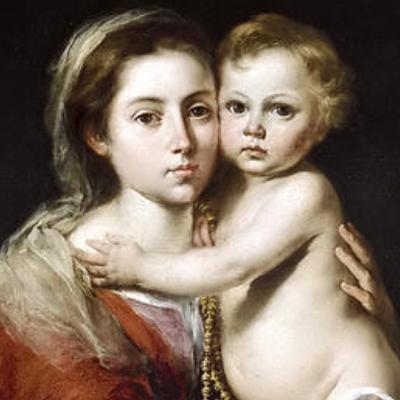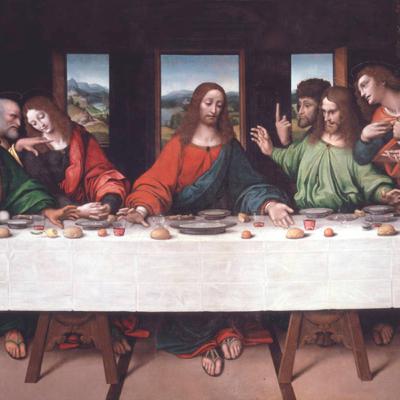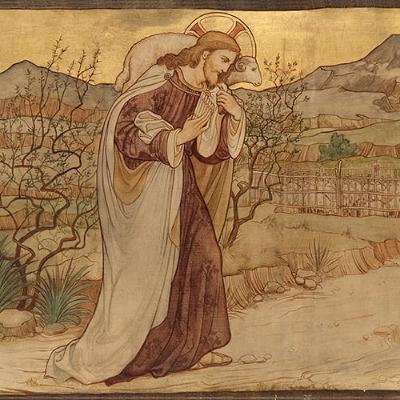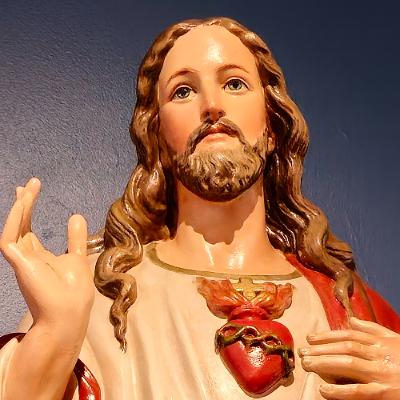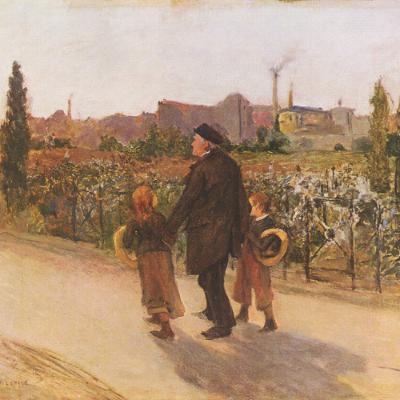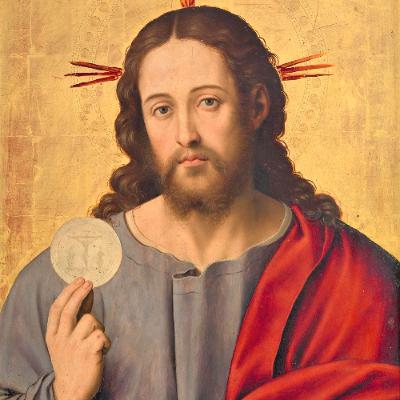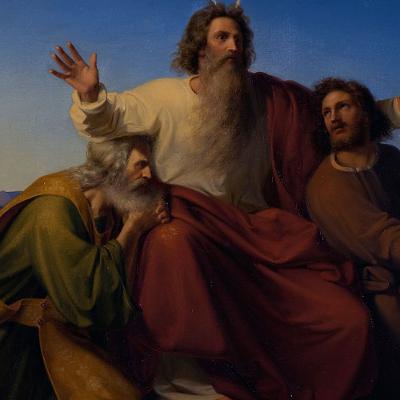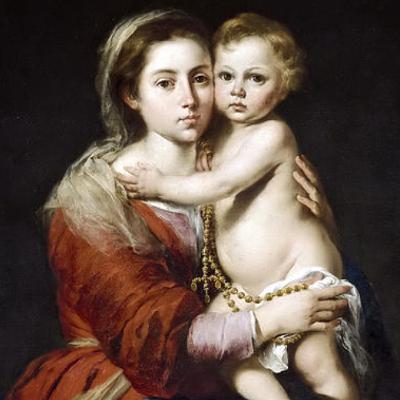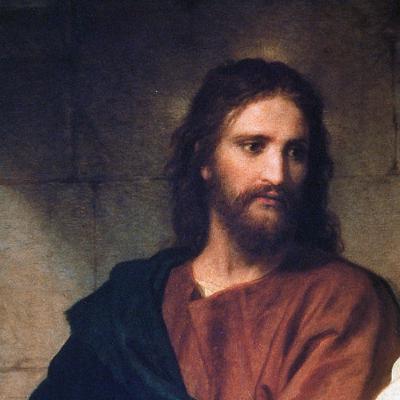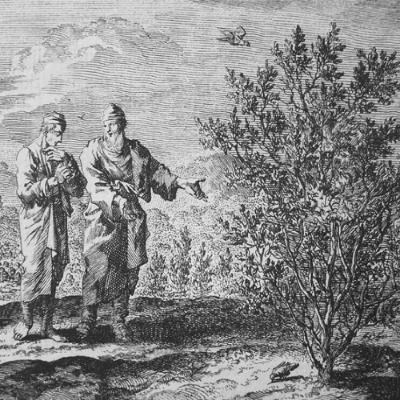Discover Ad Jesum per Mariam
Ad Jesum per Mariam

636 Episodes
Reverse
Seeing Others as Christ Sees: The Gospel Call Revealed in Soldiers and Saints
I was hungry. You fed me thirsty. You gave me to drink. I was alone, and you were with me. I was naked and you clothed me. This marvelously simple description of the greatness of Christian life.
That ability, not so much to see Jesus in each other as to see others as Jesus sees them.
Today’s Gospel draws from Matthew’s teaching on the Final Judgment, . . .
. . . where Jesus separates people as a shepherd separates sheep from goats, praising those who cared for “the least of His brothers.”
The Homily then focuses on Saint Martin of Tours, a soldier-turned-bishop whose famous act of charity . . . cutting his cloak to clothe a beggar . . . reveals the heart of the Gospel: seeing others as Christ sees them and responding with compassion. Martin’s life of disciplined holiness, service, and unwavering focus on Christ is presented as a model of Christian discipleship.
Seeing Others as Christ Sees Them
The Homily also highlights two American military chaplains whose causes for sainthood are advancing: Father Vincent Capodanno, a Marine chaplain killed in Vietnam after repeatedly risking his life to save wounded soldiers, and Father Emil Kapaun, a Korean War chaplain known for heroic sacrifice, spiritual strength, and care for fellow prisoners of war. Each embodies Christlike service . . . feeding the hungry, comforting the suffering, and valuing every human life.
On Veterans Day, the Homily emphasizes that the vocation of a soldier, when lived with compassion and courage, mirrors the Gospel call to serve others. As Christ nourishes and strengthens us in the Eucharist, we are sent forth to care for the hungry, the thirsty, and the vulnerable in our own lives, following the example of these remarkable witnesses.
Listen to:
Seeing Others as Christ Sees: The Gospel Call Revealed in Soldiers and Saints
---------------------------------------------------------------------
Art Work
Seeing Others as Christ Sees: The Gospel Call Revealed in Soldiers and Saints : AI and Queen of All Hearts’ Digital Team: 2025
Meditations on the Mysteries of the Rosary: Glorious Mysteries
One Who Descended So All Might Ascend: A Theology of the Glorious Mysteries
This conference initially explores the deep unity and movement . . .
. . . within the original fifteen mysteries of the Rosary . . . Joyful, Sorrowful, and Glorious . . . and shows how they mirror the central pattern of the Creed: Incarnation → Passion → Resurrection and Glory.
The conference highlights how only one . . . Christ . . . descends from heaven, taking on our humanity, and then ascends again carrying that humanity into glory. Mary’s Assumption confirms that where Christ has gone, we are meant to follow.
The Time Scale of the Mysteries
The meditation considers the time scale of the mysteries:
• The Joyful Mysteries span about twelve years;
• The Glorious Mysteries unfold across roughly 50 days followed by many years;
• And, The Sorrowful Mysteries, in stark contrast, take place within a single intense day.
The conference also gives attention to the public versus private character of the mysteries: Christ’s passion is witnessed by thousands, whereas the resurrection and ascension are revealed only to a small circle of disciples. Jesus does not showcase His triumph; instead, He entrusts the proclamation of His resurrection to a handful who did not even witness the moment itself.
The reflection then expands the First Glorious Mystery, urging a broader meditation on the many appearances of the risen Christ . . . from Mary Magdalene to the disciples on the road to Emmaus—emphasizing how His glorified humanity is the true pattern for our own.
The Glorious Mysteries
The Ascension is presented as Christ’s heavenly enthronement, witnessed only by His disciples. It is inseparable from the Great Commission, in which Jesus commands this small, fragile group to evangelize the nations, promising His abiding presence and the coming of the Holy Spirit.
The Third Glorious Mystery, Pentecost, reveals the Church’s true beginning. The Holy Spirit descends not randomly, but upon the Church gathered on a Sunday, in prayer, in the place of the Eucharist, with Mary. Pentecost mirrors the Incarnation: as the Spirit once formed Christ’s physical body in Mary, He now forms Christ’s mystical body, the Church.
The disciples step out into the world . . . and the world is already waiting, drawn by the Spirit. Peter’s preaching leads to the conversion of more than three thousand, marking the start of the Church’s mission to the nations.
Overall, the conference shows how the Glorious Mysteries reveal Christ’s victory, the exaltation of our humanity, the birth of the Church, and the continuation of the same divine movement from Incarnation to Redemption to Glory.
Listen to this Meditation Media. Listen to
Meditations on the Mysteries of the Rosary: Glorious Mysteries
-------------------------------------------------------------------
Art Work
Madonna of the Rosary: Spanish artist: Esteban Murillo: 1650
As in the Days of Noah: Living Prepared in Ordinary Times
Jesus warns his disciples that the coming of the Son of Man will be sudden and unexpected, . . .
. . . just as in the days of Noah and Lot, when people were absorbed in ordinary activities and unprepared for God’s intervention. Jesus urges readiness, detachment from worldly attachments, and a willingness to surrender one’s life to God.
As the liturgical year nears its end, the Church’s readings focus on the end times . . . not to inspire fear, but to remind believers that life is a journey toward God. The Homily explains that preparing for Christ’s coming involves two essential steps: acknowledging the existence of God and allowing God to influence one’s life.
The first reading from Wisdom warns against admiring creation without recognizing the Creator. True wisdom is to see beauty in the world and let it lead us to God.
What Does Being Ready Mean
The Gospel adds that being ready means letting God shape our daily lives, rather than resisting His influence. Ordinary activities become spiritually empty when God is excluded from them. Preparation involves letting God’s will challenge and transform us, trusting Him even in moments of doubt or suffering. Genuine trust requires a full surrender of the heart . . . not holding back parts of our lives from God.
The Homily concludes with an invitation to affirm love for Jesus from the heart and to let this love guide all actions and decisions.
Listen to this Meditation Media: Listen to:
As in the Days of Noah: Living Prepared in Ordinary Times
-----------------------------------------
Art Work
Noah and His Ark: American Artist: Charles Willson Peale: 1819
Noah kneels in the foreground surrounded by family and creatures.
-----------------------------------------
Gospel Reading: Luke 17: 26-37
First Reading: Wisdom 13: 1-9
Mary’s Prayer and Ours: How the Dawn of Salvation Breaks Into the World
The Gospel presents Jesus’ parable of the persistent widow and the unjust judge . . .
. . . as a lesson on the necessity of persevering in prayer. Even a corrupt judge responds to persistence . . . so how much more will God, who loves His people, answer those who cry out to Him with faith. Jesus warns that many give up too quickly, mistaking God’s “not yet” for “no,” when persistent prayer actually purifies the heart and prepares the soul to receive what God desires to give.
When the Night was Half Spent
The Homily then turns to the First Reading from the Book of Wisdom, a text the Church connects to the mystery of Christmas. It describes the moment “when the night was half spent” and the “all-powerful Word leaped down from heaven,” imagery the Church recognizes as a prophetic anticipation of the Incarnation. This dramatic vision portrays Christ as a mighty Redeemer who breaks the darkness of sin and restores creation.
The Homily also reflects on humanity’s long night of spiritual darkness from Adam and Eve onward, during which the world groaned for salvation. Throughout history God’s people cried out like the widow seeking justice. Their prayers . . . Abraham’s, David’s, the prophets’ . . . reach their fullness when Mary, conceived without sin, adds her own pure prayer. Her plea becomes the hinge of history, and in response, God sends His Son, quietly and humbly, in her womb.
The Homily further emphasizes that Mary continues to pray with and for the faithful. In this shrine dedicated to her, no one prays alone; her intercession elevates and perfects our petitions. Just as the Word once leapt from heaven in the Incarnation, He continues to do so at every Mass . . . descending upon the altar in the Eucharist for our salvation. In this mystery we recognize that we are no longer dwellers of a doomed land but witnesses of the dawn brought by Christ, the light of the world.
Listen to this Meditation Media. Listen to:
Mary’s Prayer and Ours: How the Dawn of Salvation Breaks Into the World
-------------------------------------------------------------------
View of the Sun from Long Island, NY, not too far from the Shrine.
-------------------------------------------------------------------
Gospel Reading: Luke 18: 1-8
First Reading: Wisdom 18: 14-16; 19: 6-9
The Kingdom Is Already Here: Responding to God’s Presence Today
Jesus teaches that the Kingdom of God is not something that arrives with visible signs . . .
. . . because it is already present among us. The Gospel warns against chasing dramatic predictions about the end times or following voices that claim secret knowledge about God’s plans. Christ emphasizes that His final coming will be unmistakable and needs no advance decoding, but before that He Himself must be rejected by the present generation.
The Homily reflects on how people today, like in every era, are tempted to run after loud, strident voices . . . political, cultural, or spiritual . . . that promise clarity or insight yet draw them away from the Gospel. True wisdom, the preacher notes, is quiet, penetrating, rooted in charity, and grounded in the Church’s authentic teaching.
The Kingdom of God Demands a Response Now
The Kingdom of God demands a response now, not later. Christ is already present . . . especially in the Eucharist . . . even when His presence is not visible to the human eye. The real question is not when the Kingdom will come, but how each person responds to God’s presence today. If Christians seek first the Kingdom, everything else will fall into its proper place; but if they focus on lesser things first, they risk missing the Kingdom altogether.
Listen to this Meditation Media. Listen to:
The Kingdom Is Already Here: Responding to God’s Presence Today
----------------------------------------------------------------------
Art Work
The Garden of Eden after Adam and Eve’s Departure: AI and Queen of All Hearts’ Digital Team: 2025
This website showcases masterpieces from centuries of art. Occasionally; the Queen of All Hearts’ Digital Team enhances the collection with Artificial Intelligence Art . . . a modern approach to creating art using AI technology. This particular piece portrays the Garden of Eden after Adam and Eve’s departure. In the scene, the Sun rises in the East, symbolizing God’s continued guidance for humanity.
----------------------------------------------------------------------
Gospel Reading: Luke 17: 20-25
First Reading: Wisdom 7: 22–8:1 ...
Settle Accounts While There’s Time: St. Paul’s Honesty and Christ’s Deliverance
Today’s Homily reflects on two Scripture passages . . .
. . . St. Paul’s candid confession of his inner struggle (Romans) and Jesus’ call to read the signs of the times (Luke).
St. Paul admits that although he desires to do good, he often fails, revealing the inner conflict between grace and the lingering effects of sin. His honesty shows that even the greatest saints struggle internally, reminding us that the Christian life is not a self-improvement project but a reliance on Christ, who alone delivers us from our divided selves.
The Homily then helps us to connect this with Jesus’ teaching about interpreting signs. People easily read the weather or social cues yet fail to recognize God’s movements in their own lives. Jesus urges His listeners to discern the spiritual signs around them and respond.
Discern the Spiritual Signs
Jesus warns that our lives are moving toward a final judgment, likening it to walking with an adversary toward a magistrate. Therefore, we must “settle accounts” now through repentance, charity, and works of mercy.
The Homily also touches on the Church’s understanding of purgatory . . . where remaining spiritual debts are purified . . . and highlights the importance of praying for the dead.
Ultimately, both readings invite believers to face their own struggles honestly, remain attentive to God’s grace, and live now in a way that prepares them for their final meeting with the Lord.
Listen to this Meditation Media. Listen to:
Settle Accounts While There’s Time: St. Paul’s Honesty and Christ’s Deliverance
--------------------------------------------------------------------
Art Work
The Tribute Money: Flemish Artist and Painter: Anthony van Dyck: 1623
--------------------------------------------------------------------
Gospel Reading: Luke 12: 54-59
First Reading: Romans 7: 18-25
Meditations on the Mysteries of the Rosary
The Sorrowful Mysteries
Where Wisdom Dwells: Suffering, Redemption, and the Sorrowful Mysteries
This conference explores the deep meaning of the Sorrowful Mysteries of the Rosary, . . .
. . . emphasizing that the heart of these mysteries is The Cross of Christ, the fullest revelation of God’s unconditional, unmerited love for humanity. The conference explains that while the Rosary traditionally seemed to bypass the public ministry of Jesus, the early Church understood His ministry as presupposed in the proclamation of His passion, death, and resurrection . . . the core of apostolic preaching.
The Cross of Christ
The conference highlights that the cross exposes both the radical depth of human sin (understood as love rejected) and the redemptive power of suffering when united with Christ. Drawing on St. Louis de Montfort and Scripture, the conference shows that suffering without Christ is destructive, but suffering with Christ becomes a path to holiness, hope, and resurrection.
Each of the five Sorrowful Mysteries is then examined:
1. Agony in the Garden: Jesus’ anguish reveals the weight of His mission and perfect obedience. The disciples’ betrayal and abandonment invite us to stay spiritually awake, embrace suffering with Christ, and cultivate contrition.
2. Scourging at the Pillar: This mystery summarizes the rejection of Jesus—by His people, His closest followers, the crowds, and His executioners—mirroring humanity’s own tendency to refuse God’s love.
3. Crowning with Thorns: The mock coronation exposes our inclination to choose worldly “kings” over Christ. Mary’s presence urges repentance and conversion.
4. Carrying of the Cross: Our attitude toward our personal crosses reveals our discipleship. With Christ, the cross becomes a treasure, a sign of victory, and our lifelong standard.
5. Crucifixion: At the foot of the cross, Mary stands united with Jesus, witnessing the reversal of the Fall . . . where Adam grasped the fruit of a tree, Christ now gives Himself as the true fruit that brings life.
The conference concludes by reaffirming that the Sorrowful Mysteries draw us into the heart of God’s love and the mystery of redemption accomplished through the cross.
Listen to this Meditation Media. Listen to
Where Wisdom Dwells: Suffering, Redemption, and the Sorrowful Mysteries
---------------------------------------------------------
Art Work
Madonna of the Rosary: Spanish artist: Esteban Murillo: 1650
No More Excuses: Accepting God’s Invitation to the Eternal Banquet
In the Gospel of Luke, Jesus tells the parable of the Great Banquet, . . .
where invited guests offer excuses . . . work, property, and relationships . . . to avoid attending the feast. Their refusal represents how worldly concerns can distract us from God’s invitation to eternal life. The master then opens his banquet to the poor and outcast, symbolizing God’s inclusive call to all who are willing to respond.
The Homily connects this Gospel to St. Paul’s teaching on the Body of Christ: every member has a unique gift meant to serve and build the unity of the Church, not for personal pride or division. When we neglect our role or elevate worldly pursuits . . . success, possessions, or relationships . . . above God, we disrupt both community and communion with Him.
We are reminded that at every Mass, we are invited to the Lord’s banquet. The question is whether we will accept His invitation to eternal life or let passing concerns keep us away. The faithful are urged to use their gifts in love, serve one another, and prioritize the eternal over the temporary.
Listen to this Meditation Media. Listen to:
No More Excuses: Accepting God’s Invitation to the Eternal Banquet
----------------------------------------------------------------
Art Work
Restored mural painting by the Italian Renaissance Artist Leonardo da Vinci, dated to c. 1495–1498.
The painting represents the scene of the Last Supper of Jesus with the Twelve Apostles, as it is told in the Gospel of John.
----------------------------------------------------------------
Gospel Reading: Luke 14: 15-24
First Reading: Romans 12: 5-16
Jesus Carrying the Fallen Home: Recovering the Divine Image Within
Today’s Homily examines Luke’s parables of the Lost Sheep and the Lost Coin, . . .
. . . traditionally understood as images of God’s mercy toward individual sinners. However, the Homily recalls the early Church Fathers’ broader view: that these parables describe God’s saving action toward all humanity . . . the whole human race as the “lost sheep” and “lost coin.”
Christ, the Good Shepherd, leaves heaven to rescue fallen humanity, lifting it upon His shoulders through the Cross and carrying it home in the Resurrection. Yet salvation is not passive . . . grace strengthens sinners to repent and cooperate with redemption. Those who respond actively to grace and strive to restore the divine image within themselves bring great joy to heaven.
Humanity made in God’s Image but Disfigured by Sin
The parable of the woman and the lost coin deepens this image: the coin bears the image of the King, symbolizing humanity made in God’s image but disfigured by sin. The woman’s lamp represents Christ, the light of the Incarnation, illuminating and searching the “house” of the human soul. True repentance, then, is an interior cleansing—overturning what hides God’s image until it shines again.
Finally, as November continues . . . the Church’s month of prayer for the departed . . . the Homily connects this teaching to the work of mercy in praying for souls in purgatory. Just as Christ carries fallen humanity, we carry our departed loved ones by prayer, helping them journey toward full union with God. This act renews the divine image in us as well, joining us to Christ’s redemptive mission and the joy of heaven.
Listen to this Meditation Media. Listen to:
Jesus Carrying the Fallen Home: Recovering the Divine Image Within
The Parable of the Lost Sheep: William George Rich: late 1800s
Return to Meditation Media
Gospel Reading: Luke 15:1-10
First Reading: Romans 14:7-12
The Fire of Christ’s Heart: Surrendering to Grace or to the World
Today’s Homily reflects on a challenging Gospel passage . . .
. . . where Jesus says He came not to bring peace but division. The Homily also invites us to linger with difficult Scriptures rather than skip to “favorite parts,” because they reveal essential truths about salvation.
St. Paul reminds believers that although Christ has already won victory over sin, we must still freely choose to surrender to God’s grace instead of giving in to old habits, emotions, and worldly desires.
We Must Still Freely Choose to Surrender to God’s Grace
Jesus speaks with deep urgency and longing for our salvation, revealing His burning desire to complete His saving mission on the Cross. True peace is not simply avoiding conflict or leaving things as they are; rather, Jesus brings a necessary division between the old life of sin and the new life of grace. Choosing the Kingdom means leaving behind “business as usual,” even when that causes tension within ourselves, our families, or society.
Ultimately, life presents only two paths: God’s way or the way that leads to emptiness, shame, and death. The Lord calls us to choose the way of life, to surrender to grace, and to walk with Him . . . who gives us strength in the Eucharist . . . to become truly new and free in Him.
Listen to this Meditation Media. Listen to:
The Fire of Christ’s Heart: Surrendering to Grace or to the World
-------------------------------------------------------------
Art Work
Sacred Heart of Jesus: The Shrine of Our Lady of the Island
A Season of Mercy: Humble Prayer and the Gift of Indulgences
Today’s Homily reflects on what it means to pray in a way that God truly hears us.
The readings remind us that God has no favorites, yet He shows special attention to the poor and humble because all human beings are, at our core, spiritually poor and in need of mercy. Jesus’ parable of the Pharisee and the tax collector reveal the danger of self-righteousness: when we come before God convinced of our own goodness, we close ourselves off from grace. True prayer begins with humility, honesty, and recognition of our need for God’s mercy . . . like the tax collector who simply prayed, “Have mercy on me, a sinner.”
Have Mercy On Me
The Homily then connects this lesson to the Church’s November focus on praying for the dead. Sin not only offends God but causes harm that must be repaired . . . either in this life through penance or in purgatory. The Church, in her mercy, offers special indulgences in the first eight days of November to help souls in purgatory, especially through cemetery visits, prayer, sacramental confession, and Communion.
The Shrine’s annual Novena for the Faithful Departed is also highlighted as a powerful opportunity to assist loved ones. Ultimately, the message urges humility, repentance, and charitable prayer for the deceased, trusting in God’s abundant mercy.
----------------------------------------------------------
Art Work
All Souls Day: French Painter: Jules Bastien-Lepage: 1882
----------------------------------------------------------
The Homily references a handout explaining plenary indulgences. See the webste link.
Memento Mori: Holding Onto What Matters Most in Life and Death
Today’s Homily, on All Souls‘ Day, . . .
. . . tells the story of a grieving family mourning their only daughter. When the priest arrives, people expect answers and consolation . . . but instead, he sits at the coffin and weeps with them. His tears silently communicate that death, pain, and loss are real, and sometimes there are no words . . . only presence and love.
Memento Mori
The message extends to all who mourn: the Church stands with us in grief and points us to Christ, who also wept for His friend Lazarus. Jesus shares in our suffering, prays with us, and leads us to eternal life. The reading reminds us that nothing . . . not even death . . . can separate us from God’s love and that we are created for eternal glory.
We are encouraged to remember death, to hold onto what truly matters . . . Christ . . . and to live well, knowing our time on earth is limited. Commemorating the dead comforts us, honors them, and reminds us that one day we too will be prayed for. May the souls of the departed rest in peace
Listen to this Meditation Media: Listen to:
Memento Mori: Holding Onto What Matters Most in Life and Death
-------------------------------------------------------------
Memento Mori . . .
. . . is a Latin phrase that means:
“Remember that you will die.”
It is a spiritual reminder used throughout Christian history . . . especially by monks and saints . . . to keep life in perspective. The point is not to inspire fear, but to encourage:
• humility
• living with purpose
• focusing on what truly matters (our soul and love of God)
• readiness to meet the Lord
In other words, Memento Mori invites us to live well by remembering that earthly life is temporary and eternal life is our true destination.
-------------------------------------------------------------
Art Work
All Souls’ Day: Czech Painter: Jakub Schikaneder: 1888
Heart Speaks to Heart: The Love of Christ in the Eucharist
Today’s Homily centers on St. Paul’s teaching that to truly know God’s love, . . .
. . . one must be rooted and grounded in it . . . not merely observing from a distance but living within it. The Homily then turns to St. Margaret Mary Alacoque, whose mystical experiences of Christ’s Sacred Heart revealed the depth of His love and sorrow at being loved so little in return.
Through her, Jesus emphasized that devotion to His Heart is inseparable from devotion to His Eucharistic Presence. He lamented the neglect and indifference shown toward the Blessed Sacrament, even by those consecrated to Him, and called for reparation through time spent with Him in prayer and adoration.
Heart Speaking to Heart
From her quiet convent, this message gave rise to practices such as the First Friday devotion, Holy Hours of Reparation, and the simple yet profound habit of “visiting the Lord” in the tabernacle. The reflection concludes that true devotion to the Sacred Heart is not symbolic or sentimental, but an active, personal engagement . . . heart speaking to heart . . . in which Christ’s love calls to the depths of our own hearts.
Hear more within this Meditation Media. Listen to:
Heart Speaks to Heart: The Love of Christ in the Eucharist
----------------------------------------------------------------------
Art Work
Christ the Savior with the Eucharist: Spanish Painter: Juan de Juanes: 1545 – 1550
This oil-based painting on wood is one of three parts. This part shows Our Lord holding the Eucharist and Chalice
Doing Something for God: The Missionary Call of Every Christian
Today’s Homily for the Feast of St. Luke the Evangelist . . .
. . . reminds us that, like the 72 disciples Jesus sent out, we are all called to be missionaries. This missionary call doesn’t necessarily mean traveling abroad . . . it begins in our own homes and communities.
Faith and Mission
The Homily illustrates this by comparing evangelization to talking about a favorite sport: we naturally speak about what we love. If we truly love Jesus, we should talk about Him with our family and friends and show His presence through our actions.
Jesus sends His disciples in pairs, highlighting that faith is lived in community, not isolation. As followers of Christ, we are called to bring peace wherever we go and to represent God in our words and deeds.
Listen to this Meditation Media: Listen to:
Doing Something for God: The Missionary Call of Every Christian
-----------------------------------------------------------------------
Art Work
The Good Shepherd: German Painter: Bernhard Plockhorst: (Lived) 1825-1907
Holding Up the Hands of Faith
Today’s Homily centers on the theme of persistence in prayer and faith as a mission to be passed on.
The Homily begins by contrasting today’s culture of instant gratification with the patient perseverance required in prayer. The first reading from Exodus illustrates this through Moses, whose raised hands during battle symbolize steadfast prayer and dependence on God. When his strength fails, Aaron and Hur support him . . . showing that prayer often needs the help and faith of others.
Moses’ intercession prefigures Christ’s outstretched arms on the Cross, interceding for humanity. The second reading reminds believers, as Paul told Timothy, to “keep the faith” and pass it on . . . faith handed down like a relay baton from one generation to the next.
On Mission Sunday, the Church calls every Christian to share and sustain that faith, not only through ordained ministry but also within families and communities.
The Gospel challenges us to remain faithful and persistent in prayer so that, when Christ returns, He may still find faith alive on earth. Each believer is invited to ask: Will God find faith in me, in my family, and in my world?
Listen to this Meditation Media. Listen to:
Holding Up the Hands of Faith
--------------------------------------------------------------
Art Work
Moses, Aaron and Hur: Alexander Heubel: 1837
--------------------------------------------------------------
Gospel Reading: Luke 10: 1-9
First Reading: 2 Timothy 4: 10-17
As we spend these weeks reflecting on The Mysteries of the Rosary, it is helpful to begin with something so familiar that we rarely stop to ponder it . . . the very names of the sets of mysteries themselves. Each conference will center on these sacred mysteries, inviting us to notice how the Church, in her wisdom, presents them to us in a particular and meaningful way.
Join us for three Conferences offering prayerful reflection and fresh insights into The Mysteries of the Rosary, deepening our understanding of this treasured devotion.
-------------------------------------------------------------------
Meditations on the Mysteries of the Rosary
The Joyful Mysteries: The Heartbeat of the Rosary
As we reflect over these three conferences . . . three weeks . . . on The Mysteries of the Rosary, it’s important to begin with something obvious that we seldom simply pause and consider in itself, and that is the names of the sets of mysteries. Today we are focusing on the Joyful Mysteries, and it’s important to recognize that in giving these five mysteries, this particular name as a set, the Catholic tradition is presenting them to us in a certain way.
The Joyful Mysteries remind us that our faith begins with joy . . . the joy that the Savior has come. At the heart of the Rosary is the Hail Mary, not a prayer written by man, but a heavenly greeting that began salvation history: “Hail, full of grace, the Lord is with thee.” Every mystery rests on this divine message.
The Rosary starts with The Mystery of the Annunciation . . . the Incarnation . . . the moment the Word became flesh in Mary’s womb . . . containing within it all of Christ’s life, death, and resurrection.
When We ray the Rosary, We do so with Mary
When we pray the Rosary, we do so with Mary, who helps us understand and treasure the mysteries of her Son. Her humility in the Annunciation leads to charity in the Visitation, where she “sets out in haste” to serve Elizabeth. There, joy overflows: the unborn John the Baptist leaps, Elizabeth rejoices, and Mary sings her Magnificat, the Church’s first hymn of praise. These mysteries invite us to share Mary’s joy, humility, and love as we draw closer to Jesus through her.
Listen to this Meditation Media. Listen to
The Joyful Mysteries: The Heartbeat of the Rosary
-------------------------------------------------------------------
Art Work
Madonna of the Rosary: Spanish artist: Esteban Murillo: 1650
When the Heart and Mind Agree: Finding Peace in Christ
The prophet Joel calls the priests and people to repentance and fasting, . . .
. . . warning that “the Day of the Lord” will bring judgment for those who remain unconverted but salvation for those who turn back to God with sincere hearts. True conversion means harmony between the heart and the mind . . . when our thoughts and desires are aligned with God’s truth.
Jesus illustrates this in the Gospel by confronting the Pharisees, who accuse Him of casting out demons by the power of the devil. Their hearts recognize His goodness, yet their minds reject Him out of pride and deceit, revealing an inner division. Jesus teaches that a “house divided against itself cannot stand” and warns that a heart cleansed of evil must be filled with God’s grace, or else greater evils will return.
The Homily concludes with an invitation to examine our own hearts: Are we filled with the Spirit of God or with division? True conversion brings harmony within us and, through us, harmony to our families, Church, and world. Only Christ, who is Truth itself, can bring this lasting peace and unity.
Listen to this Meditation Media. Listen to:
When the Heart and Mind Agree: Finding Peace in Christ
----------------------------------------------------
Art Work
Christ And The Rich Young Ruler (cropped): German Painter: Heinrich Hoffman: 1899
----------------------------------------------------
Gospel Reading: Luke 11: 15-26
First Reading: Joel 1: 13-15; 2: 1-2
The God Who Refuses to Be Narrow: Jonah, the Samaritan, and the Boundless Mercy of Christ by Ad Jesum per Mariam
Your Faith Has Saved You: The Power of Encountering Jesus
Today’s Homily reflects on the Gospel of the ten lepers and the Samaritan . . .
. . . who returned to thank Jesus. Building on last week’s theme, “Lord, increase our faith,” it emphasizes that true faith is not about quantity but about a living, personal relationship with Christ.
Blessings and Answered Prayers are not Ends in Themselves
The lepers shared suffering represents our shared human weakness and need for God’s mercy. Only one, the Samaritan, moves beyond gratitude to a deeper encounter with Jesus . . . he no longer stands at a distance but falls at His feet. The message is that blessings and answered prayers are not ends in themselves; they are meant to lead us to a real encounter with Christ and transformation in Him.
True salvation comes not merely from receiving God’s gifts but from drawing near to Him in faith, gratitude, and love. We are called to let our faith move us to mercy, forgiveness, and love for one another, allowing Christ to shape our lives.
Listen to this Meditation Media: Listen to:
Your Faith Has Saved You: The Power of Encountering Jesus
-------------------------------------------------------------
Art Work
Jesus Christ: German Artist and Painter: Heinrich Hoffman: 1894
Oil painting currently resides in The Riverside Church, New York City.
----------------------------------------------------------
Gospel Reading: Luke 17: 11-19
First Reading: 2 Kings 5: 14-17
Second Reading: 2 Timothy 2: 8-13
Lord, Increase Our Faith: The Power of a Mustard Seed
At the start of Mass, the congregation says “Amen” to the opening prayer, asking for God’s mercy . . .
. . . mercy that both pardons what conscience dreads and grants blessings too great to ask for. The Homily reflects on this prayer, connecting it to the Gospel where the disciples ask Jesus, “Lord, increase our faith.”
Jesus’ response and parable about faith the size of a mustard seed teaches that even a small amount of faith can accomplish great things if it is lived out . . . not by instantly fulfilling our desires, but by learning to trust God’s timing and will. Faith grows through use, through daily acts of trust and service.
The Homily emphasizes that belief is not just about ideas about God but a living trust in God. Each believer is called to say, “I believe in God,” personally and actively. Ordinary Christian life means serving, trusting, and acting in faith every day . . . not just occasionally or passively.
The Homily concludes by beautifully at the Eucharist: Jesus, the Master, comes to serve his servants. When we receive Him in Communion and pray, “Lord, increase my faith,” His response is immediate and intimate: “I am here within you . . . believe in Me.” Even a small act of belief in that moment begins the growth of faith that transforms our lives.
Listen to this Meditation Media on this parable.
Lord, Increase Our Faith: The Power of a Mustard Seed
-------------------------------------------------------------
Art Work
Parable of the Mustard Seed: Dutch Poet, Illustrator and Engraver: Jan Luyken: (lived) 1649-1712
-------------------------------------------------------------
Gospel: Luke 17: 5-10
First Reading: Habakkuk 1: 2-3; 2: 2-4
Second Reading: 2 Timothy 1: 6-8, 13-14



